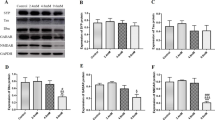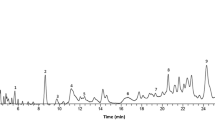Abstract
Lead poisoning is a geochemical disease. On the other hand, lead is highly carcinogenic and exhibits liver and kidney toxicity. This element can also cross the blood-brain barrier, reduce learning and memory ability and damage the structure of the cerebral cortex and hippocampus. To further investigate the mechanism of lead neurotoxicity, 4-week-old Kunming mice were used to explore the effects of different concentrations of Pb2+ (0, 2.4, 4.8 and 9.6 mM) for 9 days. In this study, pathological and ultrastructural changes in brain cells of the treated group were related to damages to mitochondria, chromatin and the nucleus. Lead content in blood was tested by atomic absorption spectroscopy, which showed high lead concentrations in the blood with increasing doses of lead. Distribution of lead in nerve cells was analysed by transmission electron microscopy with energy dispersive spectroscopy. Data showed the presence of lead in nucleopores, chromatin and nuclear membrane of nerve cells in the treatment groups, whereas lead content increased with increasing doses of lead acetate. Finally, microtubule-associated protein 2 (MAP2) mRNA and protein expression levels were detected by real-time PCR and Western blotting, which showed a reduction in MAP2 expression with increasing lead doses in the mouse brain. These findings suggest that acute lead poisoning can cause significant dose-dependent toxic effects on mouse brain function and can contribute to better understanding of lead-induced toxicity.





Similar content being viewed by others
References
Anjum MR, Madhu P, Reddy KP, et al (2016) The protective effects of zinc in lead-induced testicular and epididymal toxicity in Wistar rats. Toxicol Ind Health, 0748233716637543
ATSDR, U. S (2007) Toxicological profile for lead. US Department of Health and Human Services, 1: 582
Bansod B, Kumar T, Thakur R et al (2017) A review on various electrochemical techniques for heavy metal ions detection with different sensing platforms. Biosens Bioelectron 94:443–455. https://doi.org/10.1016/j.bios.2017.03.031
Caldas D, Pestana IA, Almeida MG, Henry FC, Salomão MSMB, de Souza CMM (2016) Risk of ingesting As, Cd, and Pb in animal products in north Rio de Janeiro state, Brazil. Chemosphere 164:508–515. https://doi.org/10.1016/j.chemosphere.2016.08.130
Chen J, Kanai Y, Cowan NJ, Hirokawa N (1992) Projection domains of MAP2 and tau determine spacings between microtubules in dendrites and axons. Nature 360(6405):674–677. https://doi.org/10.1038/360674a0
Chen L, Chen H, Yao C, Chang C, Xia H, Zhang C, Zhou Y, Yao Q, Chen K (2015) The toxicity of NaF on BmN cells and a comparative proteomics approach to identify protein expression changes in cells under NaF-stress: impact of NaF on BmN cells. J Hazard Mater 286:624–631. https://doi.org/10.1016/j.jhazmat.2014.12.056
Dai Y, Huo X, Zhang Y, Yang T, Li M, Xu X (2017) Elevated lead levels and changes in blood morphology and erythrocyte CR1 in preschool children from an e-waste area. Sci Total Environ 592:51–59. https://doi.org/10.1016/j.scitotenv.2017.03.080
de Oliveira TM, Peres JA, Felsner ML et al (2017) Direct determination of Pb in raw milk by graphite furnace atomic absorption spectrometry (GF AAS) with electrothermal atomization sampling from slurries. Food Chem 229:721–725. https://doi.org/10.1016/j.foodchem.2017.02.143
Dehmelt L, Halpain S (2004) The MAP2/Tau family of microtubule-associated proteins. Genome Biol 6(1):204. https://doi.org/10.1186/gb-2004-6-1-204
Farzin L, Amiri M, Shams H, Ahmadi Faghih MA, Moassesi ME (2008) Blood levels of lead, cadmium, and mercury in residents of Tehran. Biol Trace Elem Res 123(1):14–26. https://doi.org/10.1007/s12011-008-8106-y
Flora G, Gupta D, Tiwari A (2012) Toxicity of lead: a review with recent updates. Interdiscip Toxicol 5(2):47–58. https://doi.org/10.2478/v10102-012-0009-2
Gąssowska M, Baranowska-Bosiacka I, Moczydłowska J et al (2016) Perinatal exposure to lead (Pb) promotes Tau phosphorylation in the rat brain in a GSK-3β and CDK5 dependent manner: relevance to neurological disorders. Toxicology 347:17–28
Gillis BS, Arbieva Z, Gavin IM (2012) Analysis of lead toxicity in human cells. BMC Genomics 13(1):344. https://doi.org/10.1186/1471-2164-13-344
Guariglia SR, Stansfield KH, McGlothan J, Guilarte TR (2016) Chronic early life lead (Pb2+) exposure alters presynaptic vesicle pools in hippocampal synapses. BMC Pharmacol Toxicol 17(1):56. https://doi.org/10.1186/s40360-016-0098-1
Gulson B, Mizon K, Korsch M, Taylor A (2016) Revisiting mobilisation of skeletal lead during pregnancy based on monthly sampling and cord/maternal blood lead relationships confirm placental transfer of lead. Arch Toxicol 90(4):805–816. https://doi.org/10.1007/s00204-015-1515-8
Gumy LF, Katrukha EA, Grigoriev I, Jaarsma D, Kapitein LC, Akhmanova A, Hoogenraad CC (2017) Map2 defines a pre-axonal filtering zone to regulate kif1- versus kif5-dependent cargo transport in sensory neurons. Neuron 94(2):347–362. https://doi.org/10.1016/j.neuron.2017.03.046
Jannuzzi AT, Alpertunga B (2016) Evaluation of DNA damage and DNA repair capacity in occupationally lead-exposed workers. Toxicol Ind Health 32(11):1859–1865. https://doi.org/10.1177/0748233715590919
Jin X, Xu Z, Zhao X, Chen M, Xu S (2017) The antagonistic effect of selenium on lead-induced apoptosis via mitochondrial dynamics pathway in the chicken kidney. Chemosphere 180:259–266. https://doi.org/10.1016/j.chemosphere.2017.03.130
Kazemeini F, Malayeri BE, Chehregani A et al (2013) Identification of the heavy metals accumulator plants in surrounding area of mine. Int J Agric Crop Sci 6(10):565
Kubatiev AA, Pal'tsyn AA (2012) Intracellular brain regeneration: a new view. Vestnik Rossiiskoi akademii meditsinskikh nauk 8:21–25
Leasure JL, Giddabasappa A, Chaney S, Johnson JE Jr, Pothakos K, Lau YS, Fox DA (2008) Low-level human equivalent gestational lead exposure produces sex-specific motor and coordination abnormalities and late-onset obesity in year-old mice. Environ Health Perspect 116(3):355–361. https://doi.org/10.1289/ehp.10862
Nascimento CRB, Risso WE, dos Reis Martinez CB (2016) Lead accumulation and metallothionein content in female rats of different ages and generations after daily intake of Pb-contaminated food. Environ Toxicol Pharmacol 48:272–277. https://doi.org/10.1016/j.etap.2016.11.001
Neal AP, Worley PF, Guilarte TR (2011) Lead exposure during synaptogenesis alters NMDA receptor targeting via NMDA receptor inhibition. Neurotoxicology 32(2):281–289
Nihei MK, Guilarte TR (2001) Molecular changes in glutamatergic synapses induced by Pb2+: association with deficits of LTP and spatial learning. Neurotoxicology 22(5):635–643. https://doi.org/10.1016/S0161-813X(01)00035-3
Piechnik CA, Höckner M, de Souza MRDP, Donatti L, Tomanek L (2017) Time course of lead induced proteomic changes in gill of the Antarctic limpet Nacella Concinna (Gastropoda: Patellidae). J Proteome 151:145–161. https://doi.org/10.1016/j.jprot.2016.04.036
Rosen MB, Pokhrel LR, Weir MH (2017) A discussion about public health, lead and Legionella pneumophila in drinking water supplies in the United States. Sci Total Environ 590:843–852
Shenai-Tirodkar PS, Gauns MU, Mujawar MWA, Ansari ZA (2017) Antioxidant responses in gills and digestive gland of oyster Crassostrea madrasensis (Preston) under lead exposure. Ecotoxicol Environ Saf 142:87–94. https://doi.org/10.1016/j.ecoenv.2017.03.056
Sohail M, Khan MN, Qureshi NA, Chaudhry AS (2017) Monitoring DNA damage in gills of freshwater mussels (Anodonta anatina) exposed to heavy metals. Pak J Zool 49(1):305–311. https://doi.org/10.17582/journal.pjz/2017.49.1.305.311
Sun H, Wang N, Nie X, Zhao L, Li Q, Cang Z, Chen C, Lu M, Cheng J, Zhai H, Xia F, Ye L, Lu Y (2017) Lead exposure induces weight gain in adult rats, accompanied by DNA hypermethylation. PLoS One 12(1):e0169958. https://doi.org/10.1371/journal.pone.0169958
Suzuki N, Ando S, Sumida K, Horie N, Saito K (2011) Analysis of altered gene expression specific to embryotoxic chemical treatment during embryonic stem cell differentiation into myocardiac and neural cells. J Toxicol Sci 36(5):569–585. https://doi.org/10.2131/jts.36.569
Verma M, Tyagi I, Chandra R, Gupta VK (2017) Adsorptive removal of Pb (II) ions from aqueous solution using CuO nanoparticles synthesized by sputtering method. J Mol Liq 225:936–944. https://doi.org/10.1016/j.molliq.2016.04.045
Verstraeten SV, Aimo L, Oteiza PI (2008) Aluminium and lead: molecular mechanisms of brain toxicity. Arch Toxicol 82(11):789–802. https://doi.org/10.1007/s00204-008-0345-3
Wagner PJ, Park HR, Wang Z, Kirchner R, Wei Y, Su L, Stanfield K, Guilarte TR, Wright RO, Christiani DC, Lu Q (2017) In vitro effects of lead on gene expression in neural stem cells and associations between up-regulated genes and cognitive scores in children. Environ Health Perspect 125(4):721–729. https://doi.org/10.1289/EHP265
Yang QQ, Xue WZ, Zou RX, Xu Y, Du Y, Wang S, Xu L, Chen YZ, Wang HL, Chen XT (2016) β-Asarone rescues Pb-induced impairments of spatial memory and synaptogenesis in rats. PLoS One 11(12):e0167401. https://doi.org/10.1371/journal.pone.0167401
Zhang YW, Yan L, Huang L (2016) Cerebral ganglion ultrastructure and differential proteins revealed using proteomics in the aplysiid (Notarcus leachii cirrosus Stimpson) under cadmium and lead stress. Environ Toxicol Pharmacol 46:17–26. https://doi.org/10.1016/j.etap.2016.06.021
Funding
This work was supported by the National Science Foundation of China (No. U1404329), Postdoctoral Science Foundation of China (No. 2014M561205), Scientific and Technological Foundation of Henan Province in China (172102110026) and Scientific and Technological Foundation of Henan Province Department of Education in China (No. 14A230006).
Author information
Authors and Affiliations
Corresponding author
Additional information
Responsible editor: Philippe Garrigues
Rights and permissions
About this article
Cite this article
Ge, Y., Chen, L., Sun, X. et al. Lead-induced changes of cytoskeletal protein is involved in the pathological basis in mice brain. Environ Sci Pollut Res 25, 11746–11753 (2018). https://doi.org/10.1007/s11356-018-1334-6
Received:
Accepted:
Published:
Issue Date:
DOI: https://doi.org/10.1007/s11356-018-1334-6




